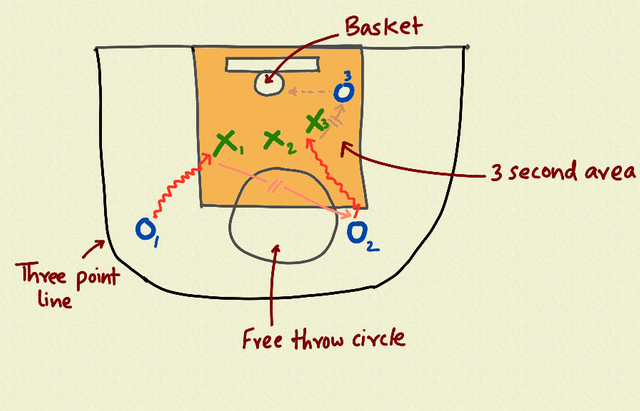How to write a business playbook

In sports, a playbook describes plays, a preset plan of action.
It's a number of moves - a strategy - to move a team into the right places to score.
A playbook is not a woolly wishlist - it's practical, tactical stuff.
So, how can a business playbook help us be more effective?
Let's take a very simple example and draw out the most basic business operation possible in a consulting firm.
In basketball playbooks, the court has a number of zones and a basket.
Offensive players are denoted with a O and defensive players with an X.
Lets start with an engagement - a practice lead (O1) enagages with a customer contact (X1).
O1 dribbles the ball (the wavy red line), starting the conversation.
What this very first interaction reminds us is that X1 is not the target.
The target is to be useful - to solve a problem, make money, save money and so on.
That is the basket we are heading for at the end of the court.
When X1 and O1 have decided that there is some merit in this and worked out a problem they would like to solve together (identified the basket), the practice lead passes to an operations lead (O2).
The pass is shown by a line with two slashes. Quite often, people just assume others should know what to do, but a playbook shows that a clear pass is needed, perhaps with an update meeting or formal handover.
X1 may also involve other stakeholders, X2 and X3. O2 now needs to dribble towards the stakeholder team and come up with specific work packages and deliverables.
Finally O2 passes to a consultant or analyst (O3) that does the work, shoots and scores.
Drawing the play in this way also brings out a few other aspects.
O3 needs to deliver the work quickly.
The player is in the 3-second area, and you can't linger in there. Get things done fast and the customer will appreciate it.
O1 is stood in the three point area.
It might be possible to shoot from there, but its a long shot. Instead, it makes sense to do the play and get closer to the basket.
In other words, rather than guessing and trying to make a quick decision, engaging and understanding the client's requirements is more useful.
In some cases, we might be offered a free throw - a chance to prove ourselves - with a demo or a pilot piece of work.
We need to put the best player on there to try and make the shot.
It's interesting how, with just a few components, one can draw out a fairly complex business interaction and make the crucial elements clear.
For example, how many projects have you seen where not having a clear handover or pass meant that requirements weren't understood and it took longer?
How many times have you seen players going for the long shot when actually getting closer to the basket may have delivered the project?
Running a business is less about wishes and more about action oriented plays with our teams - and those are the things that need to go in a playbook.
Read more posts at Karthik-Suresh.com.
Isn't that just the same idea as a process flow?
Yes it is. Most ideas can be reduced down to nodes and connections of one kind or another. The idea here, however, is to also experiment with lenses - a playbook approach might appeal to sales teams in the same way a process flow appeals to operations teams. Horses for courses and all that...